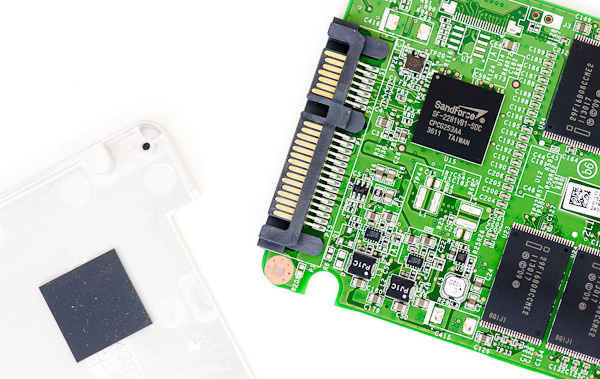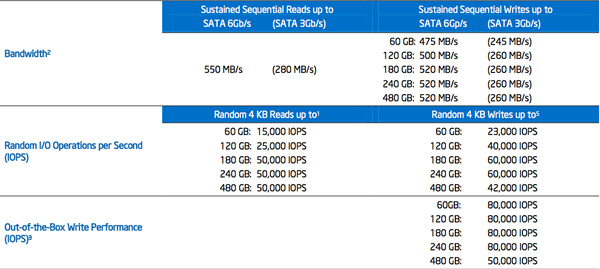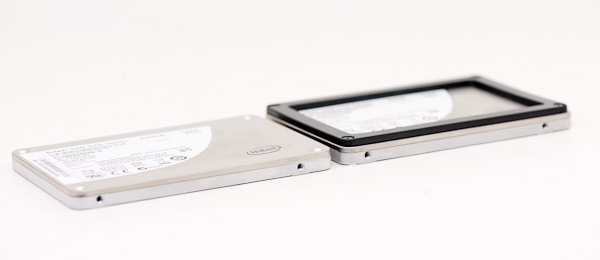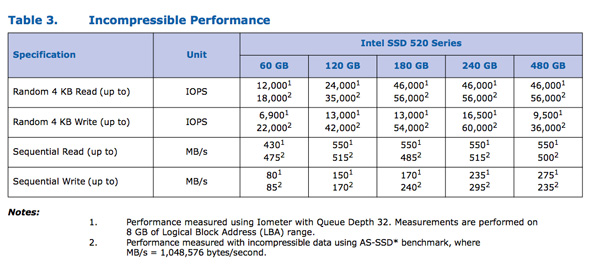Intel SSD 520 Review: Cherryville Brings Reliability to SandForce
by Anand Lal Shimpi on February 6, 2012 11:00 AM ESTThe Intel SSD 520
Intel sent us a 240GB and 60GB SSD 520 for review, but the performance specs of the entire family are in the table below:
The Intel SSD 520 is available in both 9.5mm and 7mm versions, with the exception of the 480GB flavor that only comes in a 9.5mm chassis. The 520's uses Intel's standard 7mm chassis with a 2.5mm removable plastic adapter that we've seen since the X25-M G2. The plastic adapter allows the drive to fit in bays designed for 9.5mm drives. Note that Intel doesn't ship shorter screws with the 9.5mm drives so you can't just remove the plastic adapter and re-use the existing screws if your system only accepts a 7mm drive.
Inside the drive we see the oh-so-familiar SandForce SF-2281 controller and Intel 25nm MLC NAND. The controller revision appears unchanged from other SF drives we've seen over the past year. The PCB design is unique to the 520, making it and the custom Intel firmware the two noticeable differences between this and other SF-2281 drives.

Intel uses the metal drive chassis as a heatsink for the SF-2281 controller
The SF-2281 Controller
I've explained how the SF-2281 works in the past, but for those of you who aren't familiar with the technology I'll provide a quick recap. Tracking the location of data written to an SSD ends up being one of the most difficult things a controller has to do. There are a number of requirements that must be met. Data can't be written to the same NAND cells too frequently and it should be spread out across as many different NAND die as possible (to improve performance). For large sequential transfers, meeting these (and other) requirements isn't difficult. Problems arise when you've got short bursts of random data that can't be combined. The end result is leaving the drive in a highly fragmented state that is suboptimal for achieving good performance.
You can get around the issue of tracking tons of data by simply not allowing small groups of data to be written. Track data at the block level, always requiring large writes, and your controller has a much easier job. Unfortunately block mapping results in very poor small file random write performance as we've seen in earlier architectures so this approach isn't very useful for anything outside of CF/SD cards for use in cameras.
A controller can rise to the challenge by having large amounts of cache (on-die and externally) to help deal with managing huge NAND mapping tables. Combine tons of fast storage with a fast controller and intelligent firmware and you've got a good chance of building a high performance SSD.

SandForce's solution leverages the work smart not hard philosophy. SF controllers reduce the amount of data that has to be tracked on NAND by compressing any data the host asks to write to the drive. From the host's perspective, the drive wrote everything that was asked of it, but from the SSD's perspective only the simplest representation of the data is stored on the drive. Running real-time compression/de-duplication algorithms in hardware isn't very difficult and the result is great performance for a majority of workloads (you can't really write faster than a controller that doesn't actually write all of the data to NAND). The only limit to SandForce's technology is that any data that can't be compressed (highly random bits or data that's already compressed) isn't written nearly as quickly.
Intel does a great job of spelling out the differences in performance depending on the type of data you write to the SSD 520, but it's something that customers of previous Intel SSDs haven't had to worry about. Most client users stand to benefit from SandForce's technology and it's actually very exciting for a lot of enterprise workloads as well, but you do need to pay attention to what you're going to be doing with the drive before deciding on it.
The Intel SSD Toolbox
The Intel SSD 520 works flawlessly with the latest version of Intel's SSD Toolbox. The toolbox allows you to secure erase the drive from within Windows, and it also allows you to perform firmware updates and pull SMART info from the drive. Unlike other SandForce toolboxes, Intel's software works fine with Intel's RST drivers installed.

The Test
| CPU | Intel Core i7 2600K running at 3.4GHz (Turbo & EIST Disabled) - for AT SB 2011, AS SSD & ATTO |
| Motherboard: | Intel DH67BL Motherboard |
| Chipset: | Intel H67 |
| Chipset Drivers: | Intel 9.1.1.1015 + Intel RST 10.2 |
| Memory: | Corsair Vengeance DDR3-1333 2 x 2GB (7-7-7-20) |
| Video Card: | eVGA GeForce GTX 285 |
| Video Drivers: | NVIDIA ForceWare 190.38 64-bit |
| Desktop Resolution: | 1920 x 1200 |
| OS: | Windows 7 x64 |























138 Comments
View All Comments
borynek - Saturday, February 11, 2012 - link
I am very curious how does the encryption option work in Intel SSD 520? Does it use ATA password? When I connect it to another computer or via USB the data cannot be read?schouwla - Monday, February 13, 2012 - link
I am not very excite about the new SSD from Intel. How does it stack up against A-DATA AS510S3-120GM-C that has reads at 550 MB/S and writes at 510 MB/S. A 120G disk is 11500 yen in JapanMadMacMan - Monday, February 13, 2012 - link
I'm what you would call a "power user" I suppose and I've used SSD's for several years. I had an X25-M G1 for the longest time and when Intel decided not to go after the speed crown anymore after the X25-M G2, and instead focus on reliability with the 320, I jumped ship. I love the fact that Intel is BACK with the 520 and although I'm surprised at the controller choice (SF-2281), it's still Intel and while only time will tell if it will have been a good purchase, but I'm going to get the 180GB version of the 520 series.I do have some experience with SF-2281 drives and they are all positive. At first, I was using two 120GB OWC Mercury EXTREME Pro 6G SSD's in RAID 0 in a 2011 Mac mini, which has SATA III (6Gbps) support. They ran like a dream using Apple's software RAID 2.0. Sequential speed tests for reads and writes were consistently above 900MB/s and sometimes approaching the 1GB/s mark, although I never went over. This setup lasted 3 months when I attempted to do the same when I switched into my (Late-2011) 17" MacBook Pro, but due to an issue having SOLELY to do with Apple, I am restricted to using only one of my SSD's. Needless to say, speeds dropped to around 500MB/s, but my machine runs beautifully and is still kick-ass at those rates. (On a side note, when I researched the issue, the 13" MBP, for some inexplicable reason, DOES run beautifully with 2 SSD's from OWC (i.e. SF-2281) in RAID 0, but not the 15" and 17" ones. As I said, this has NOTHING to do with the fact that they are SF-2281 drives.
The bottom line here is that I have had a combined 6 months experience with specifically the SF-2281 from OWC and they have been flawless for me and again, my system is on 24/7 and gets plenty of use. To give you an idea just how much use, I upgraded to 16GB of RAM recently, because 8GB simply wasn't enough.
So as I said, I will sell both of my 120GB OWC drives to raise some money for one of these, most likely the 180GB version. According to one of the charts in the review, the 180GB and 240GB run at almost the exact same speed (as opposed to the 120GB and 60GB variants). That's a sweet spot for me as far as capacity and price point are concerned. I'm looking forward to going back to Intel, although OWC's drives have been great!
e-kirill - Thursday, February 16, 2012 - link
I am thinking about buying Intel 520 180GB for my iMac 27" (mid 2011, MC814, OS X Lion 10.7.3), going to swap factory HDD with sweet (?) Intel 520.What do you think, guys, is it a good choice, considering NO TRIM factor for non-factory SSD under OS X Lion?
Yes, I know about TRIM Enabler (http://www.anandtech.com/show/5453/trim-enabler-20... but I am just ... not sure, how will it work over time.
It would be great to know your thoughts.
Thanx in advance!
SezeMakto - Friday, February 17, 2012 - link
First post ever! I'm torn between 3 SSDs. The Samsung 830 256GB for $340 delivered, the Samsung 830 512GB for $675 delivered, or an Intel 520 240GB for $500 delivered... Any help? Thanks.TheJian - Friday, March 2, 2012 - link
You report Trim doesn't do squat with this drive. Then how do they report trim works in seconds here using SSD Optimizer. You can even set it to scheduled so you don't worry about trim any more:http://www.hardwarecanucks.com/forum/hardware-canu...
If this is true, your whole article needs to be changed to say it's the best drive out there with trim or without even in XP etc.
Am I wrong? I almost bought but now want intel instead. Your article almost steered me to M4 just to avoid sandforce. I'm rethinking that now as maybe Intel really is WORTH the money.
TRIM WORKS FINE ON THIS DRIVE. USE THE TOOLBOX. How did you miss this??
zenith1 - Monday, March 12, 2012 - link
"Performance in this worst case scenario isn't terrible but the fact that it's irrecoverable even after a TRIM is what's most troubling."I am a bit unsure about this worst case scenario, does this mean that if I get into this corner case, there is no way at all to restore the drives performance? It will not help to free up some space or, as a last resort, a secure erase?
Would not mind any pointers on this issue, if it has been thoroughly discussed before. Just a bit mind boggling if there is no solution to this problem.
cansande - Thursday, March 15, 2012 - link
A couple of days ago the price was around 206 for the 120. It dropped to 199 and then 179 today. It looks like Intel may start to be more competitive with ocz and others. 10 dollars more than a vertex 3. Reliability and a 5 year warranty is 10 dollars more. I'll take it.kzinti - Monday, April 16, 2012 - link
I got myself an Intel 520 SSD (180GB) two weeks ago. While installing windows, I got 2 BSOD (dreaded F4), both resuming from hibernate. So I dissable hibernate and any power saving option. The drive worked fine for a week (so I forgot all about it).Then I started getting random freeze and last night, BSOD (F4) within 10 min of each reboot.
This was on an Asus P5K Deluxe, Bios updated to 1005 and ICH9R controller to 8.7.0.1007.
I put back my old system drive to reformat the SSD and that took me a dozen attempt. The SSD drive would keep locking up and disconnecting.
Since I removed the SSD, my system is stable as it always' been.
I am returning it today. I sure hope these new drives aren't plaggued with the same problem.
kzinti - Wednesday, April 18, 2012 - link
Exchanged the faulty SSD and haven't had a single problem in 3 days. The shop guy was genuinely surprised and said no one ever returned an Intel SSD. Well, I guess now there is one. =)